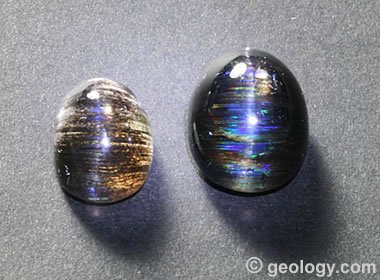Scapolite
A name used for the solid-solution mineral pair of marialite and meionite.
Article by: Hobart M. King, PhD

Cat's-eye scapolite: Some scapolite has an internal silk that causes it to form a cat's-eye or a chatoyance. The stone on the left is a 10 x 7 millimeter oval with a very coarse silk. The silk can be seen in the stone as linear bands of black inclusions that cross the stone from left to right. The cat's-eye forms at right angles to the silk. In the stone on the right, the silk has just the right spacing to serve as a diffraction grating and produce a beautiful display of iridescent color. Both gems were cut from material produced in India.
What is Scapolite?
Scapolite is a name used for a group of aluminosilicate minerals that includes meionite, marialite, and silvialite. Meionite and marialite are end members of a solid solution series. Silvialite is a mineral that is very similar to meionite.
These minerals have very similar compositions, crystal structures, and physical properties. They cannot be easily distinguished from one another in the field or during hand specimen examination in a laboratory. The name "scapolite" is a term used for convenient communication. These minerals are found in small quantities in some metamorphic and igneous rocks. Their compositions are compared in the table below.
| Mineral | Chemical Composition |
| Meionite | Ca4(Al2Si2O8)3(CO3,SO4) |
| Marialite | Na4(AlSi3O8)3Cl |
| Silvialite | (Ca,Na)4(Al2Si2O8)3(CO3,SO4) |

Scapolite crystals: Scapolite crystals of about 1 inch in length on matrix. Scapolite is one of a small number of minerals that have crystals with a square cross-section. These light purple crystals were found in Pakistan. Specimen and photo by Arkenstone / www.iRocks.com.

The best way to learn about minerals is to study with a collection of small specimens that you can handle, examine, and observe their properties. Inexpensive mineral collections are available in the Geology.com Store. Image copyright iStockphoto / Anna Usova.
Physical Properties of Scapolite
Scapolite has an appearance that is very similar to many feldspars. As a result, it can easily be overlooked in the field and during hand specimen examination in a laboratory.
Massive scapolite is found in regionally metamorphosed rocks such as marble, gneiss, and schist. These massive specimens often exhibit a wood-grain or fibrous texture which facilitates their identification. Well-formed, gem-quality, prismatic crystals with a square cross-section are sometimes found in marbles.
In metamorphosed igneous rocks, especially gabbro and basalt, scapolite often occurs as complete or partial replacements of the feldspar grains. Crystals of scapolite are sometimes found in pegmatites and rocks altered by contact metamorphism.
Scapolite minerals are easily attacked by weathering. They are some of the first minerals attacked in their host rocks and easily alter to micas and clay minerals. As weathering begins, the mineral grains lose their transparency, become opaque, and have a reduced hardness.
Physical Properties of Scapolite |
|
| Chemical Classification | Silicate |
| Color | Colorless, white, gray, yellow, orange, pink, purple |
| Streak | White |
| Luster | Vitreous |
| Diaphaneity | Transparent to translucent |
| Cleavage | Good |
| Mohs Hardness | 5 to 6 |
| Specific Gravity | 2.5 to 2.7 |
| Diagnostic Properties | Luster, specific gravity, massive specimens often have a wood-grain or fibrous appearance, prismatic crystals have a square cross-section |
| Chemical Composition | A solid solution between marialite (Na4(AlSi3O8)3Cl) and meionite (Ca4(Al2Si2O8)3(CO3,SO4)) |
| Crystal System | Tetragonal |
| Uses | Faceted gemstones and cat's-eye cabochons |

Faceted Scapolite: Transparent scapolite can be cut into beautiful faceted gems that are often clear, yellow, pink, or purple in color. It is rarely seen in jewelry because it is not commonly available, and the public is unfamiliar with the gem. It has a hardness of only 5 to 6, which is soft for a ring stone. This stone is a 13 x 10 millimeter oval cut from material produced in India.
Uses of Scapolite
Scapolite does not have a role as an industrial mineral. It is rarely found in minable quantities and does not have a composition or physical properties that make it of industrial use.
The only use of scapolite is as a minor gemstone; however, in that use it can be beautiful and interesting. Yellow and pink transparent scapolite can be cut into very attractive gems like the yellow scapolite shown on this page. Some specimens contain tiny fibrous inclusions that produce a "silk" within the stone that reflects light to form a cat's-eye. A specimen with a coarse silk that forms both a cat's-eye and a diffraction grating is shown in the photo at the top of this page.
Scapolite has a Mohs hardness of between 5 and 6, which is too soft to serve as a ring stone. Its use is therefore limited to being a collector's stone and being mounted in jewelry such as earrings and pendants that have a low risk of impact or abrasion.
| More Minerals |
 |
Herkimer Diamonds |
 |
The Acid Test |
 |
Tumbled Stones |
 |
Zircon |
 |
Fool*s Gold |
 |
Kyanite |
 |
Rock Tumblers |
 |
Rhodochrosite |

Find Other Topics on Geology.com:

|

| ||

|

| ||

|

| ||

|

|
